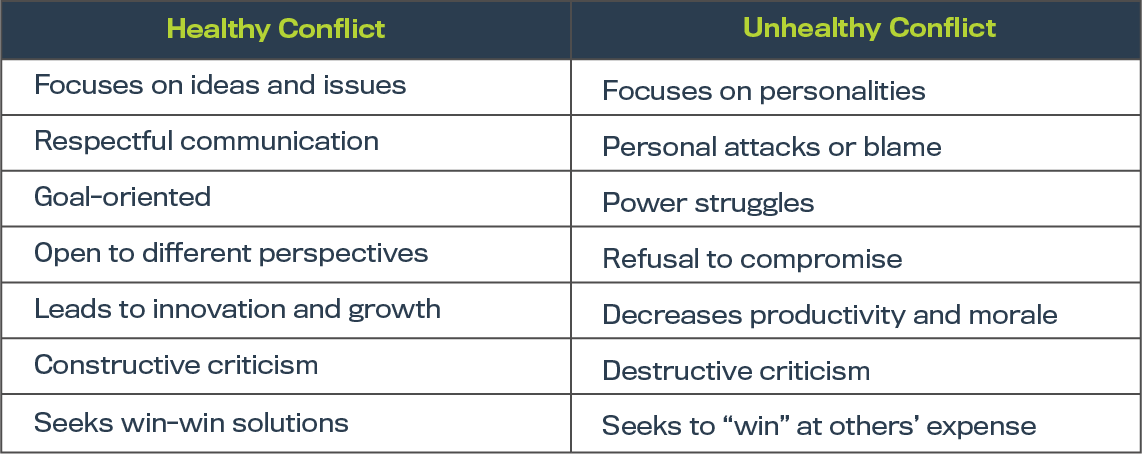8 Things to Keep in Mind When Handling Employee Disputes
Originally published on September 26, 2024
Updated on November 13th, 2024
Employee disputes are an inevitable part of any workplace. Left unchecked, they can derail productivity and morale. With remote teams, generational differences and social tensions, workplace conflicts become even more complex.
In HR, you’re not just managing disagreements; you’re also navigating a minefield of potential legal issues, productivity losses and employee retention challenges.
This article explores eight key considerations for handling employee disputes, providing practical strategies to not only resolve conflicts but also create a more resilient and productive work environment.
What Is Healthy Conflict in the Workplace?
Before diving into specific strategies for handling employee disputes, it’s vital to recognize the difference between healthy and unhealthy conflict in the workplace.
Healthy conflict can lead to innovation, growth and improved problem-solving. It involves respectful disagreements and constructive discussions that benefit the organization. Unhealthy conflict, on the other hand, can be destructive, damaging employee morale and productivity. It often stems from personal attacks, power struggles or a lack of respect for differing opinions.

Understanding these dynamics is crucial for managing disputes. It enables you to create an environment where constructive disagreements lead to innovation and growth.
By implementing the following strategies, you can create a more resilient workplace culture that views conflict as an opportunity for improvement rather than a threat to harmony. That’s foundational to improving the overall HR health of your business.
1. Identify and Address Conflicts Early
One of the most critical aspects of managing employee disputes is addressing them as soon as they arise. People often avoid conflict, which can lead to escalation and more significant problems down the line.
Early intervention sets the tone for a proactive approach to conflict resolution and shows employees that their concerns are valued. By addressing issues promptly, you can:
- Prevent problems from growing
- Show the organization takes concerns seriously
- Resolve conflicts before positions become entrenched
Implement a system for employees to report concerns confidentially and train managers to recognize and address conflicts early. The goal is to handle issues before they spiral.
2. Offer Conflict Resolution Training to Managers
Effective conflict resolution often starts with frontline supervisors and managers – but many lack training in this area. Often, technically competent employees are promoted to supervisory roles without being trained in people management skills, such as conflict resolution, which helps new managers understand how to navigate difficult conversations in the workplace.
Get ahead by proactively training in:
- Active listening
- De-escalation strategies
- Mediation
- Understanding different conflict styles
Comprehensive training for supervisors and managers can significantly reduce the likelihood of minor disagreements escalating into major conflicts. Consider ongoing training programs rather than one-time sessions to reinforce these critical skills over time.
3. Foster a Respectful Company Culture
Creating a healthy company culture, where feel valued and respected can significantly reduce the occurrence of unhealthy conflicts. This culture starts at the top and should be reinforced at all levels of the organization.
To promote respect:
- Encourage open and honest communication
- Celebrate diversity and inclusion
- Recognize and reward collaborative behaviors
By promoting a culture of respect, organizations can create an environment where conflicts are less likely to arise and easier to resolve. Respect is the foundation of healthy conflict and productive disagreements.
4. Establish Clear Policies and Procedures
Well-defined policies for handling disputes provide a framework for employees and managers to follow. Including these policies in your employee handbook helps prevent misunderstandings and promotes fair treatment.
Key elements to include:
- Protocols for filing and addressing grievances
- Anti-harassment and anti-discrimination policies
- Conflict resolution procedures
Review and update these policies regularly to keep them relevant and effective. Clear policies serve as cornerstone for addressing disputes consistently and fairly.
5. Maintain Objectivity (Or Delegate to Someone Who Can)
When mediating disputes, it’s necessary to remain impartial. Objectivity helps build trust and supports fair outcomes for all parties.
Stay objective by listening to all sides of the story without judgment and focusing on facts rather than emotions.
However, sometimes it’s easier said than done. If you can’t stay objective, or if the issue is complex, consider bringing in a neutral third party, such as HR, to mediate.
Objectivity and neutrality are essential for ensuring a fair resolution. Train managers to recognize their biases and approach conflicts with an open mind.
6. Document Everything
Proper documentation is important when handling employee disputes, providing legal protection and helping to track patterns or recurring issues. It also offers a clear record of the dispute resolution process, which can be invaluable if further action is required.
Be sure to document:
- Dates and times of incidents or meetings
- Statements from all parties
- Actions taken to address the dispute
- Outcomes and follow-up plans
Proper documentation protects the organization and maintains consistency in how disputes are handled over time. Implement a standardized system for documenting disputes and train all relevant staff on its use.
7. Know When to Escalate
While many disputes can be resolved at the managerial level, it’s important to recognize when escalation is needed. Signs include:
- Allegations of harassment or discrimination
- Threats of legal action
- Conflicts involving multiple departments or leadership
- Disputes that could impact company reputation
Establish clear guidelines for when and how to escalate issues, and make sure all managers are familiar with these procedures.
8. Follow-up and Learn
After resolving a dispute, follow up with the parties involved and use the experience as a learning opportunity for the organization. Following up demonstrates a continued commitment to employee well-being and helps prevent similar issues from arising in the future.
Post-resolution steps should include:
- Checking in with employees to ensure the resolution is effective
- Identifying any underlying issues that may need addressing
- Using insights gained to improve policies or training programs
Use each dispute as a chance to refine your conflict resolution processes and to identify areas where additional training or policy updates may be needed.
Don’t Let Disputes Derail Your Workplace
Handling employee disputes effectively is a critical skill for managers. By addressing issues proactively and objectively, you can foster a healthy and productive work environment. Offering soft skills training like mediation and conflict resolution sets your team up for success.
Not sure where to start? James Moore HR Solutions can help. Our team of experienced HR consultants can develop conflict resolution policies and train your managers, so they have the tools and confidence they need to manage any conflict that comes their way.
Contact us today to learn how we can help you manage any dispute.
All content provided in this article is for informational purposes only. Matters discussed in this article are subject to change. For up-to-date information on this subject please contact a James Moore professional. James Moore will not be held responsible for any claim, loss, damage or inconvenience caused as a result of any information within these pages or any information accessed through this site.
Other Posts You Might Like

